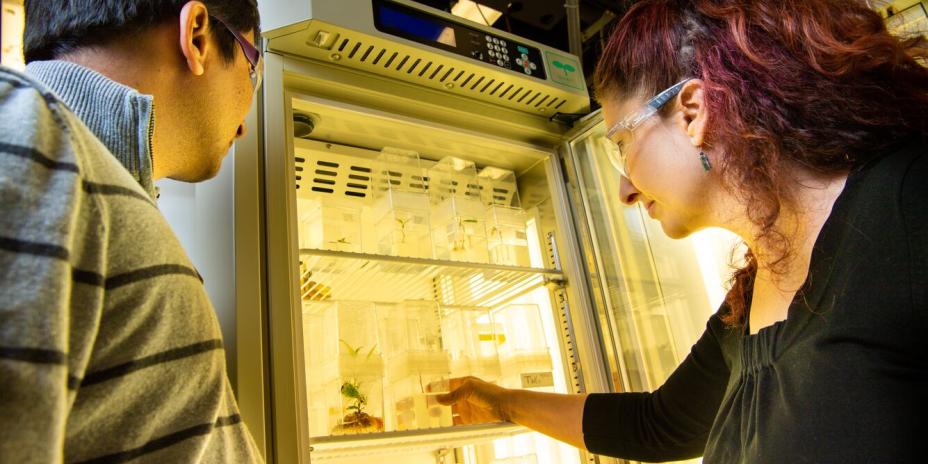Plant Growth Chambers

EMSL’s Plant Sciences Laboratory houses several reach-in and walk-in plant growth chambers. These plant growth chambers allow researchers control of many environmental variables for smaller-scale plant growth and plant-microbe experiments. Carbon dioxide levels (elevated or lowered from ambient), humidity, light cycle, and temperature can be controlled in all chambers. Select chambers are additionally modified to allow for stable isotope (i.e., 15 N2, 13 CO2) labeling or specific light spectrum/intensity experiments. Depending on your needs, these chambers can be further modified to contain rhizoboxes for plant-microbe-soil interaction studies or can house specialized plant growth apparatuses such as hydroponic growth platforms.
Studying plant systems in these chambers furthers EMSL’s broader mission of understanding Earth systems and biological processes. Specifically, these chambers enable the characterization and understanding of plant-mineral-microbe interactions, metabolic pathways, carbon and nitrogen flux, and genotype to phenotype research. Data obtained from studies conducted in these chambers aid in providing the data necessary for modeling and simulation of complex environmental systems on manageable scales and are ideal for studying model plant systems like Arabidopsis, Setaria, and Brachypodium; Sorghum; and Poplar tree and other plant species.
Research application
- Supporting the Biomolecular Pathways Integrated Research Platform, these growth chambers aid research into the functional components of plant systems. Furthering scientific understanding of cellular communication can help us improve resource use and create a more resilient environment.
- Supporting the Rhizosphere Function Integrated Research Platform, these growth chambers facilitate plant-system-scale studies that probe complex interactions between plants and the environment, helping us grow targeted crops or engineer plants with desirable attributes such as drought tolerance or disease resistance.
- Supporting the Cell Signaling and Communication Integrated Research Platform, these growth chambers enable studies into cellular-level communication in plant systems. Probing such interactions provides a critical understanding of biological systems behaviors and responses to environmental changes.
Available instruments
- Stand-alone growth chambers (Percival AR66L, Percival PGC-15, Percival CU36LS, Conviron walk-in BDW40 chambers)
- In-house built root boxes with controlled soil hydraulics capabilities and sampling ports
- Gas chambers have been constructed to fit some chambers for stable isotope labeled gas experiments
- Dynamic Environmental Photosynthetic Imager (DEPI) environmental growth chamber
- Within the chamber is a lighting array of high-power white LEDs capable of delivering full sunlight intensities and can be programmed to simulate light intensity changes that occur in the field throughout the solar day. Multiple cameras within the chamber can remotely image the plants without removing them from the conditions under which they are grown. DEPI can track maximum efficiency (Fv/FM), photosynthetic efficiency (ɸII), photoprotection (NPQ, qE, qI), growth, chloroplast movement, leaf movement, and stomatal conductance.
Tips for success
- When making inquiries to use these resources, provide the following details:
- what chamber conditions are needed for your experiment (e.g., CO2, temperature, light cycle, humidity)
- what chamber space requirements, time, and duration you will need (to coordinate chamber usage with other users)
- what labor resources you will need to best support your experiment (e.g., watering/fertilization/planting/thinning requirements).


